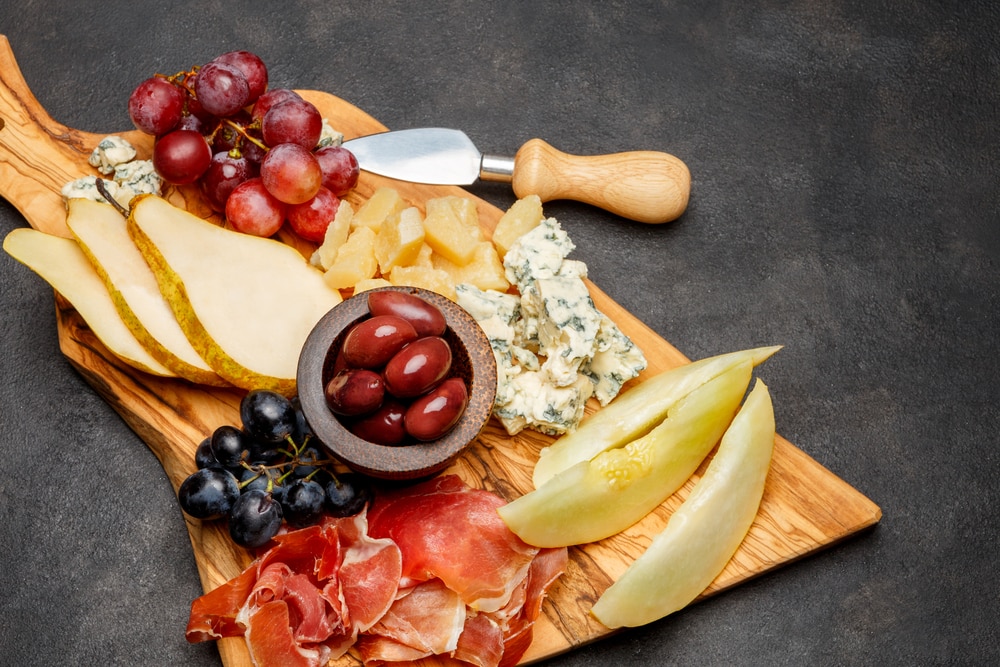
Cooking at home has been the most tried and tested activity while people aren’t able to travel. It’s been a means of keeping busy, a chance to learn new skills, and a way of expressing creativity.
We’ve spent time trying to recreate our favorite meals from our travels. I’m relatively adept in the kitchen, we have a well-stocked pantry, and within certain broad guidelines, we’re adventurous in trying new dishes. Sometimes, though, I want something quick and easy. Something that doesn’t require hours of time in the kitchen. That’s where the charcuterie plate comes in.
We’ve seen versions of the charcuterie plate in Italy, Greece, and throughout the Meditteranean. We’ve seen it at restaurants across the United States and around the world. It’s easy to assemble (even if you’re an amateur in the kitchen), doesn’t require any cooking, and can be enlarged if there are more people at your table than initially planned for.
There is no set recipe that you must follow when creating a charcuterie board. If you want to keep to a strict country theme, there are some ingredients more typical of one country vs. another. But we like to mix it all up, adding in our favorite ingredients from around the world, and the key to keeping it simple is a well-stocked refrigerator and pantry. Stock up on your favorite meats, cheeses, and nibbles – we have all-time favorites from trips to Italy – and you’ll have a simple, ready-to-go meal in nothing flat.
Let’s walk through the steps to create a colorful yet easy-to-make meat and cheese platter. You can make it an appetizer, part of party foods, or – as we do – make it dinner. I’ve included some of our favorites options.
What is a Charcuterie Board?
First off, let’s understand what a charcuterie board is! It sounds so fancy-schmancy, but it’s a very common menu item.
Charcuterie is a French word that refers to the art of preparing smoked or cured meats. Simply stated, a charcuterie board is a meat and cheese board embellished by the addition of fruits, crackers, nuts, and bread. It involves the arrangement of varieties of cured meat, cheese, and finger food served on a board or platter. You may see it on a menu listed as a charcuterie board, meat and cheese platter, meat and cheese board, or antipasto plate.
Choosing Your Cheese Board
Think of the cheese board as your base. It should be large enough and sturdy enough to hold your ingredients. Simple is fine, but this is also a time you can flaunt your creativity. Boards come in a variety of materials including wood, marble, ceramic, glass, and slate.
Wooden cheese boards are probably the most commonly seen. They are usually round or rectangular, some with handles or indentations making them easy to carry. You’ll need larger than you think you do, so there’s room not only for your artful arrangement of food but also so that it’s not so crowded that food falls off.
If you do not have any kind of board or platter handy, you could place a layer of parchment paper on your kitchen island or countertop and assemble the meat and cheese platter there.
We generally use a glass plate when it’s just for the two of us at home. When entertaining, we have a simple board that we purchased when we were traveling in Greece. It’s practical and pretty and makes for a nice presentation.
This is a close approximation, although ours is bigger.
Best Cheese For a Charcuterie Board
Once you have decided on the type of cheeseboard to use, it’s time to make your cheese selections. Three or four different varieties of cheeses are a nice assortment, but feel free to go wild, if you want. Be sure to include both hard and soft varieties of cheeses. You can place the soft cheese as a block or wedge and hard ones can be sliced or cubed while arranging the charcuterie board.
Here’s what we recommend makes a nice assortment.
Soft Cheese
I love the creaminess of soft cheeses, and you can find them available from cow, goat, or sheep’s milk. There are varying degrees of squishiness – some are smooth and runny like a spread, others are soft and chewy with a bit of tang, and you’ll see words like soft or semi-soft.
We will generally choose a Brie, one of Tony’s favorites, often looking for something we tried while in France. I love the smoothness of burrata, although it’s not always available. And we both like a smooth and spreadable triple cream.
Some other soft cheeses that work well on a charcuterie platter are fresh mozzarella, Neufchatel, gorgonzola, chevre, camembert, Roquefort, blue, havarti, young Gouda, and simple cream cheese.
Have a knife handy for spreading. Something like this is nice. We have a couple of holiday-themed cheese knives as well, although at home, we usually just grab our daily flatware out of the drawer.
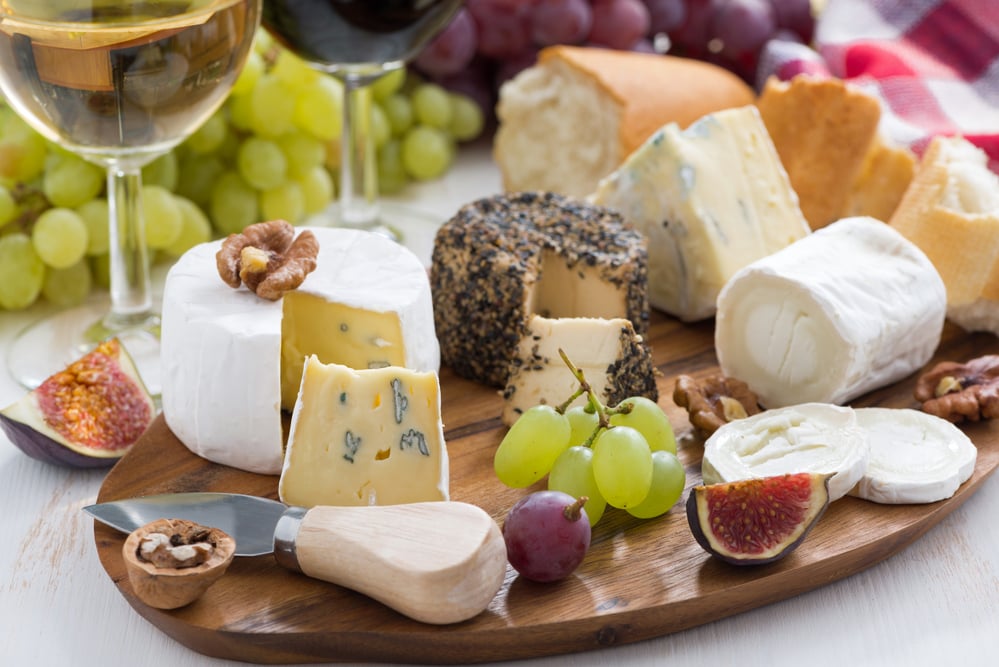
Hard Cheese
Hard cheeses are drier (less water) than soft cheeses and come in varying degrees of firmness. You’ll see words like hard and semi-hard on the packaging.
Our favorite hard cheeses to use are any type of Pecorino (we fell in love with this cheese when visiting Italy and are glad that it is now more readily available in our home area), Parmesan, and some type of Cheddar. Cheddar often seems to get a bad rap, so we’re always on the lookout for interesting choices from different parts of the world.
Some other hard cheeses that work well on a charcuterie platter are Manchego, Swiss (there are lots of varieties), aged Gouda, Provolone, and Comte (can be very expensive).
Other Cheese
Although we’re typically not fans, pre-made cheese balls, spreads, and dips are also popular on cheese boards. They’re easy, have a fairly long shelf-life so can be kept on hand, and can be presented nicely.
A cheese ball can be placed at the edge of a charcuterie board with a cutting knife. Spreads and dips can be transferred into a small ramekin (here’s a nice example) and then arranged on or alongside the board.
Best Meat For a Charcuterie Board:
Any cured meat works well for a charcuterie board. While this is most typically what you’ll see, there are other meat options that shouldn’t be dismissed.
Meats can be sliced, diced, cubed, rolled, and layered. I confess, I’m not that creative. Our charcuterie boards are usually sliced meats, artfully (HA!) arranged in an overlapping pattern. You do you!
Traditional Cured Meats for Charcuterie
We will always have some type of salami (our current favorite is a sopresseta) and prosciutto. We’re hooked on the good stuff from Italy and are willing to pay the price to get it here at home. We’d rather have the really good stuff (and prosciutto can be expensive), even if that means less of it.
Other popular cured meats for a charcuterie plate include ham (you can’t go wrong with Iberico ham from Spain), bacon, chorizo, pepperoni, and various other sausages.
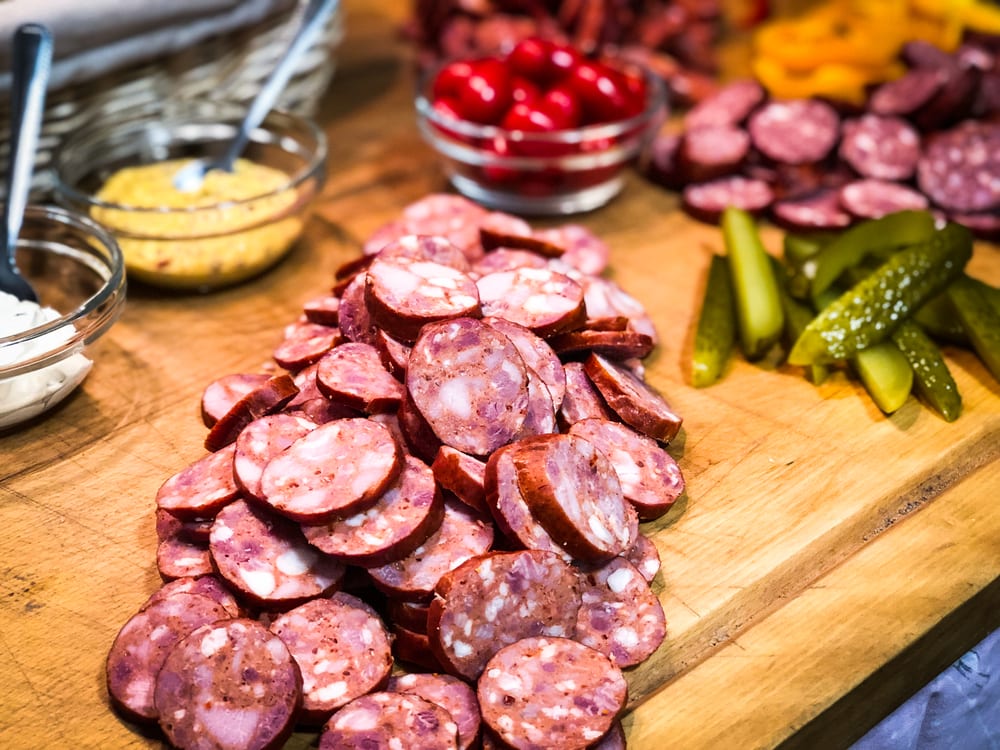
Other Meats for Charcuterie
Softer meats can also work well on a meat and cheese platter. We generally do not add these, they’re just not our favorites, but we certainly see them while dining out, especially in Europe.
These can include a slide of pate, a pot of confit, galantine, or a terrine. Pate can be sliced and place on the board and the others transferred to a ramekin (as with the cheese spreads).
Finger Food to Add to a Charcuterie Board
Any finger food style ingredient can be used while creating the charcuterie board. We keep many of these as staples in the pantry and refrigerator so they’re always on hand. While our personal taste preference runs toward savory, rather than sweet, both are important for a well-balanced charcuterie board. This is also a chance to round out the board with a variety of textures.
Bread & Crackers
Bread and crackers can add some crunch to your charcuterie board and they also serve as a mini-platter for the other board ingredients. We are always changing up our choices, although we do try to keep an assortment of crackers in the pantry, so we only have to get bread fresh.
Some good bread choices for a charcuterie board include baguettes (especially in your in France and can get them fresh from a local bakery), pita bread, toasted rounds, a soft, chewy French bread, and even naan.
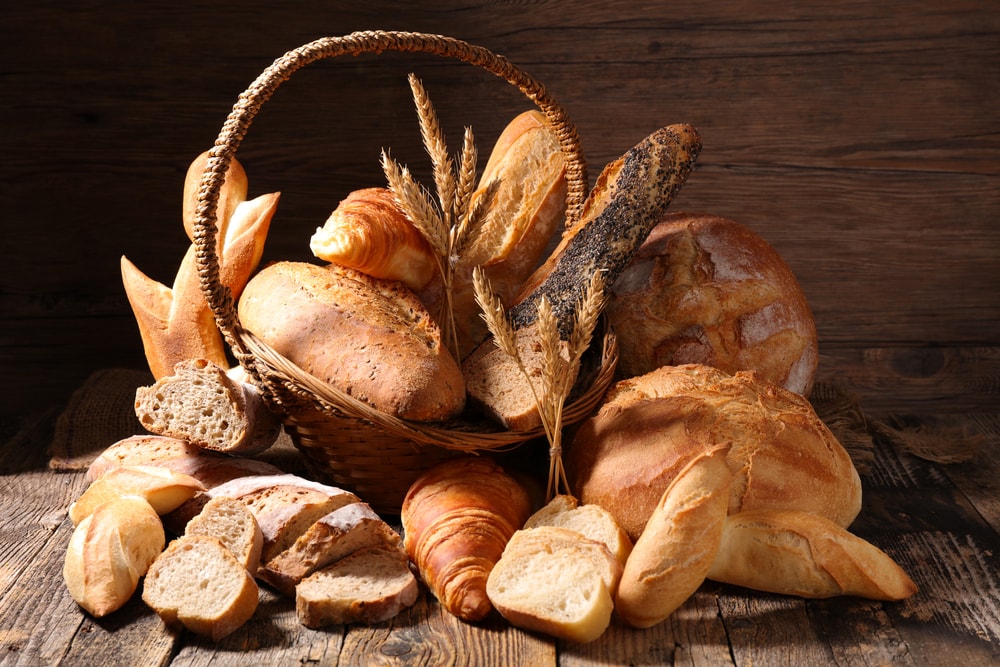
Some good cracker choices for a charcuterie board include simple butter crackers (we like the old standby, Ritz) and multi-grain crackers (again, we go basic and like Triscuit). We are not sophisticated when it comes to crackers, but this is a chance to try some new choices – pita crackers, muesli crisps, rice crackers, and toasted croutons.
Bread and crackers can be placed on the board if you have a large one, but we generally use a nice basket, lined with a cloth napkin, and place it on the side. We have one like this.
Fruits & Vegetables
We have so many favorites! Generally speaking, we pick up what’s fresh at the market and build from there.
Good fruit choices include fresh berries (this is always my top choice if they’re in season), dried cherries or cranberries, raisins, mandarin segments, pineapple chunks, and dried apricots. Occasionally I’ll add in chocolate-covered blueberries and choose to consider that a fruit.
Vegetables are a little easier to keep in the pantry as you can opt for pickled versions. We typically add olives to our meat and cheese platters, usually green olives and Kalamata, and always have those on hand.
Other good veggie choices include cherry tomatoes, thinly sliced red onion, fresh carrot and celery slices, radishes, and red pepper slices. Add some tang to the flavor palate with pickles (sour and sweet), sun-dried tomatoes, or other pickled vegetables like onions, green beans, or okra.
Fruit and veggies can be placed among the meat and cheese, but they can often be a nuisance rolling around and off the board. For the two of us, I’ll put everything on the platter. If there are more people, I’ll use ramekins on the side. You can add small serving spoons or forks (these are simple); some people like to add toothpicks for individual spearing.
Nuts & Spreads
Add your favorite nuts to your meat and cheese platter. Our favorites are cashews and smoked almonds, as they add some crunch and flavor variety. Other popular choices are walnuts, pecans, pistachios, and peanuts.
Some additional spreads can add both sweet and piquant flavors to your board. Some of our favorites are fig preserves and high-quality honey. Other good options are jams and preserves, mustards, and high-quality butter with flavored salt flakes (we saw butter added to plates in France, but haven’t incorporated it at home yet).
These items can be arranged on the plate or served alongside in small bowls. Don’t forget small spoons and knives for easy serving.
Garnish
I’ll be honest. I never worry about garni because I build out a robust board and think it looks just fine. Those olives and pickles and nuts are garnish enough for me. But, in a restaurant, it’s common to see a sprig of rosemary, a snip of dill, or a leaf of sage.
How to Assemble a Charcuterie Board?
Clean the Platter
Assembling all the ingredients to create a perfect charcuterie board is the most fun part. First off, make sure the board is clean and ready for food. Most wooden boards come with specific instructions regarding care. If it doesn’t, just follow care instructions like you would for a wooden salad bowl or other wooden serving platter. I wash mine up before storing it for the next use, occasionally adding a very light coating of olive oil to keep it in good shape. Then it just needs a quick wash before using it again.
Plan Your Layout
Plan the layout of food, taking into consideration the main elements and then the garnish. If you want to get elaborate, you can plan it out on paper before starting to assemble.
As you plan, keep in mind that an attractive display won’t have too many similarly colored and/or textured ingredients next to each other. Instead, create a rainbow order of dark to light-colored foods. I don’t do this when it’s just for two, but for entertaining, I try to splash it out – presentation is key when creating a charcuterie and cheese board.
Putting it All Together
For easier assembling, arrange all the small bowls containing wet ingredients first. Keep them well spaced out over the board. If you plan to put them alongside the board, map out what you plan to put where.
Next, arrange the cheese and the meat. Place the blocks and cubes first, then move on to organize the slices and rolls. Play with different arrangements to avoid overlapping styles. Sometimes the plan loses something in the execution, so don’t be afraid to deviate.
With the larger items assembled, you’re ready to fill in the leftover spaces with the smaller items. There is no right or wrong way to assemble the cheese board set, so let your creativity flow in creating the presentation. As much as possible, though, you should try to fill up all the space on the board. We never find this to be a problem as we often use a charcuterie plate as dinner (more on that below).
Bread and crackers can be placed cascading from bowls, spilling onto the board (if not set out in separate baskets). And finally, add in you fruits, nuts, vegetables, and garnishes to finish it up.
If you’ve created your platter for a party, you’ll want to organize your unused items so that you can quickly restock through the evening.
Charcuterie Tips
It may seem daunting at first, but with practice, creating a charcuterie board is quicker, easier, and many times healthier (and nutritious) than cooking an entire meal. It is a perfect snack to nibble when hanging out with friends or family, and it makes a great menu option when traveling or picnicking.
Here are a few additional tips that may make things easier for you:
- Add a small set of serving knives and toothpicks near the cheese and meat cubes and wedges so that people can cut and slice through and help themselves.
- Use a diverse set of ingredients to ensure that there’s something on the cheese platter for everyone. Of course, if it’s just for you, select all your favorites.
- While selecting staples for your meat and cheese platter, make sure to include bright colored ingredients that pop against the board’s color. This is where herbs for green, cherries and tomatoes for red, olives and grapes for black, different cheeses for shades of yellow, etc., can be helpful.
- Wash, cut, slice, or prepare all the staples to be placed on the charcuterie board ahead of time. This will help in creating the appetizer in only a few minutes.
- Remember, although a meat and cheese platter is as much about looks as it is about taste, in the end, it’s all about personal preferences.
Beverages
We pair our charcuterie plate with a glass of robust red wine, often a Sangiovese. It’s not quite like being in Italy, but the closest we’re going to get for now. A sparkling wine (we like Prosecco) also pairs nicely with the salty cured meats. If you prefer a non-alcoholic choice, sparkling fruit juice (cranberry, apple, white grape) is a good alternative.
For Pinterest
Save this to your favorite Pinterest boards and recreate a charcuterie board that will bring back memories of your travel. It will make a quick meal, too. Double-duty!
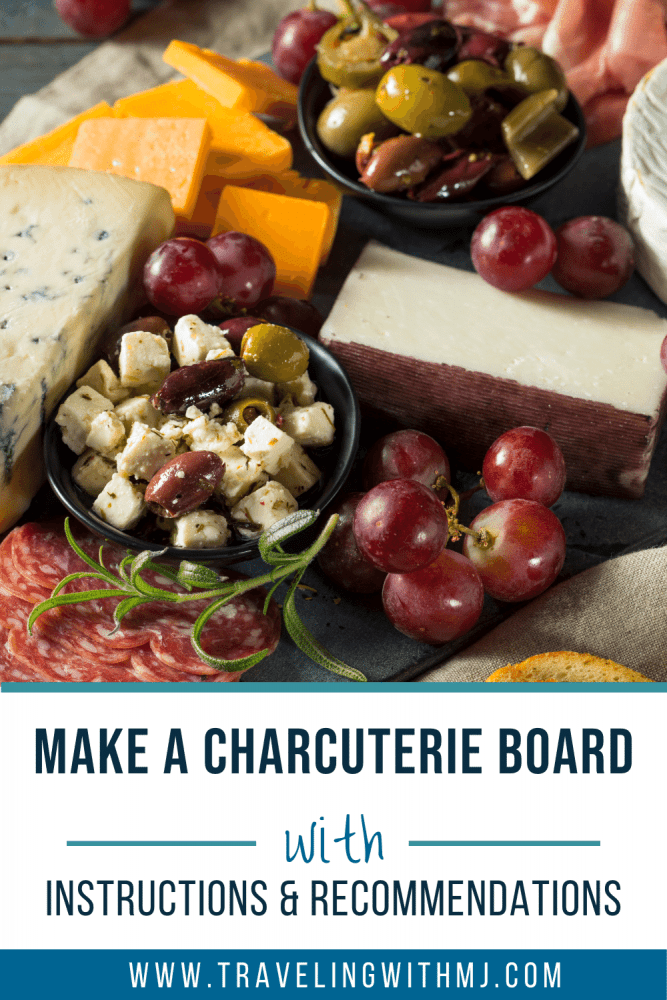
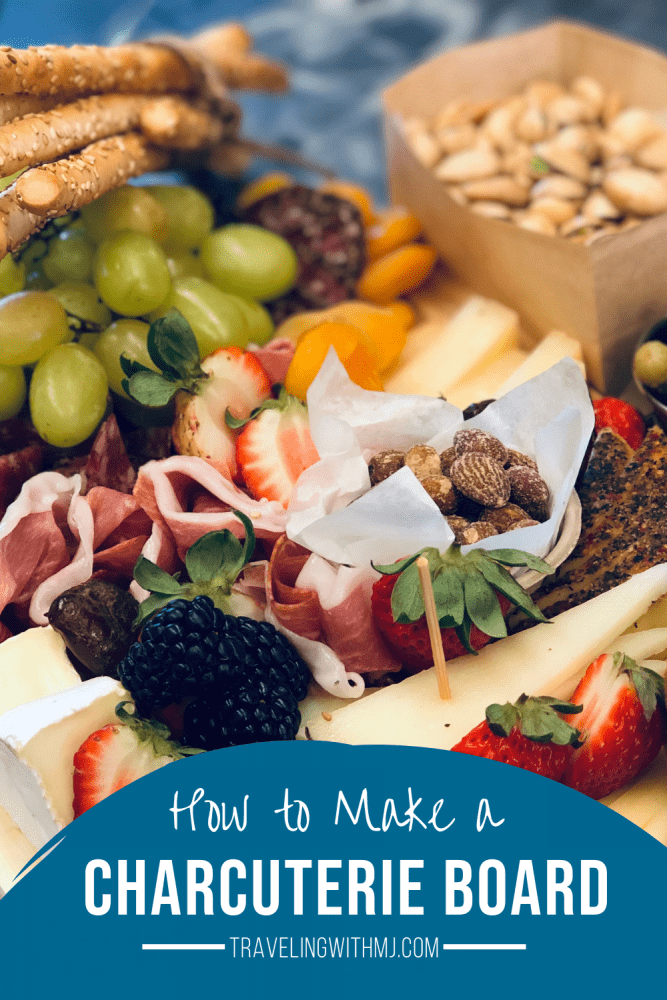
DISCLOSURE: This post contains affiliate links.

